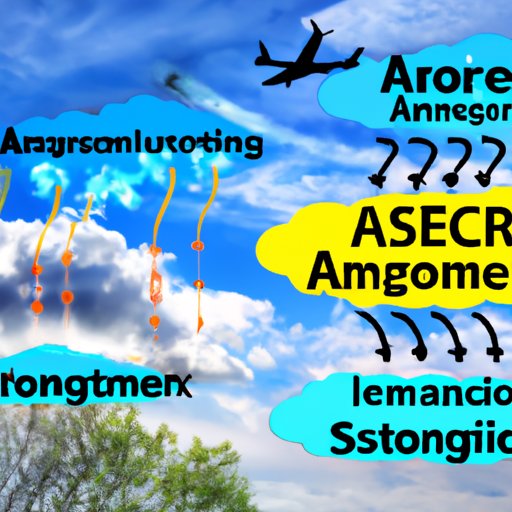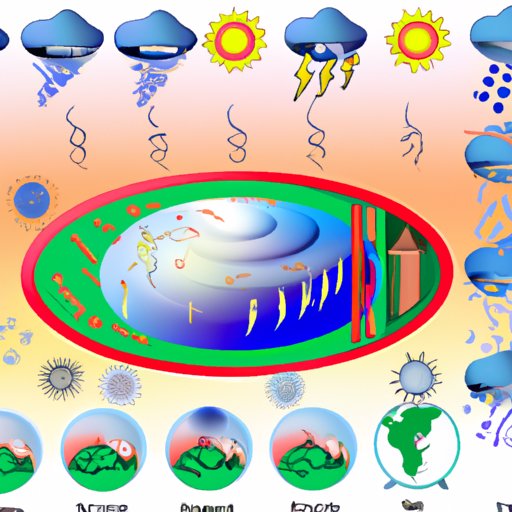Introduction
Atmospheric science is a branch of Earth science that studies the physical, chemical, and biological properties of the atmosphere. It is an interdisciplinary field of study that combines elements from meteorology, oceanography, chemistry, physics, and other disciplines to understand how the atmosphere works and how it affects our planet. The purpose of this article is to explore the basics and comprehensive guide of atmospheric science.
Exploring the Basics of Atmospheric Science
What is Atmospheric Science? Atmospheric science is the study of the atmosphere and its many components, such as temperature, pressure, winds, clouds, precipitation, and air pollution. It is also concerned with understanding how these components interact with each other and how they influence the environment. According to the National Center for Atmospheric Research (NCAR), “Atmospheric science is the study of the atmosphere, its composition, dynamics, and interactions with the sun, oceans, land surface, and life forms.”
The Different Fields of Atmospheric Science Atmospheric science is divided into several different fields, including meteorology, climatology, atmospheric chemistry, and atmospheric physics. Meteorology is the study of the atmosphere, weather, and climate. It seeks to understand the processes that create and control the weather and climate. Climatology is the study of long-term weather patterns, such as seasonal changes and long-term climate trends. Atmospheric chemistry is the study of the chemical composition of the atmosphere and how it is affected by human activities. Atmospheric physics is the study of the physical properties of the atmosphere, such as temperature, pressure, humidity, and wind velocity.
The Interaction Between Weather and Climate Weather and climate are two closely related concepts in atmospheric science. Weather is the day-to-day condition of the atmosphere, while climate is the average weather pattern over a longer period of time. Weather can change quickly, while climate is more gradual and stable. Weather is affected by short-term atmospheric processes, while climate is determined by long-term factors, such as the Earth’s orbit around the sun and the amount of carbon dioxide in the atmosphere.

A Comprehensive Guide to Atmospheric Science
The Processes Involved in Atmospheric Science Atmospheric science is based on the study of physical, chemical, and biological processes that occur in the atmosphere. These processes include the transfer of energy from the sun to the Earth’s surface, the formation of clouds and precipitation, the movement of air masses, and the circulation of air in the atmosphere. Understanding these processes is essential for predicting and understanding the weather and climate.
Tools Used in Atmospheric Science Atmospheric scientists use a variety of tools to study the atmosphere, including satellites, radiosondes, weather balloons, radar, and computer models. Satellites provide detailed information about the atmosphere from space, while radiosondes measure temperature, pressure, and humidity from the ground. Weather balloons are used to measure the altitude of clouds, while radar is used to detect storms and map their paths. Computer models are used to simulate the atmosphere and predict future weather and climate conditions.
Understanding the Data Collected by Atmospheric Science Atmospheric scientists use the data collected by these tools to understand the atmosphere and develop forecasts. They analyze this data to determine the current state of the atmosphere and make predictions about future weather and climate. The data collected helps them to understand the processes that control the atmosphere and to develop models to forecast future weather and climate.
Investigating the Nature of Atmospheric Science
The Role of Atmospheric Science in Understanding Earth’s Climate Atmospheric science plays an important role in understanding Earth’s climate. By studying the atmosphere, scientists can learn how the Earth’s climate has changed over time and how human activities have contributed to climate change. This knowledge can help us better prepare for and adapt to the effects of climate change.
The Causes of Changes in Weather and Climate Weather and climate are both affected by a variety of natural and human-caused factors. Natural causes of changes in weather and climate include volcanic eruptions, solar activity, and changes in the Earth’s orbit. Human-caused factors include burning fossil fuels, deforestation, and the release of greenhouse gases into the atmosphere.
The Impact of Atmospheric Science on Human Health Atmospheric science is also important for understanding how the atmosphere affects human health. Air pollution, ozone depletion, and other environmental problems can all have an impact on human health. By studying the atmosphere, scientists can better understand the sources of these pollutants and develop strategies to reduce their impacts.

The Role of Atmospheric Science in the Environment
The Effects of Atmospheric Science on Air Quality Atmospheric science is vital for understanding the effects of air pollution on the environment. By studying air pollution, scientists can identify the sources of pollutants and develop strategies to reduce their impacts. This knowledge can be used to improve air quality and protect the environment.
The Impact of Atmospheric Science on Water Resources Atmospheric science is also important for understanding the effects of climate change on water resources. As the climate changes, the availability of water may also change, affecting the availability of drinking water, irrigation, and other uses of water. By studying the atmosphere, scientists can better understand how climate change is affecting water resources and develop strategies to protect them.
The Influence of Atmospheric Science on Land Use Atmospheric science can also be used to understand how climate change is affecting land use. For example, changes in temperature or rainfall can alter the way land is used, which can have an impact on crop yields and other aspects of food production. By studying the atmosphere, scientists can better understand how climate change is affecting land use and develop strategies to mitigate its impacts.

Examining the Impact of Atmospheric Science on Society
The Role of Atmospheric Science in Developing Sustainable Solutions Atmospheric science is also important for developing sustainable solutions to the challenges posed by climate change. By studying the atmosphere, scientists can identify the most effective strategies for reducing emissions and adapting to the effects of climate change. This knowledge can be used to develop policies and technologies that will help society transition to a low-carbon economy.
The Benefits of Atmospheric Science for Decision Making Atmospheric science can also be used to inform decision making at all levels of society. By providing a deeper understanding of the atmosphere and its effects on the environment, atmospheric science can help governments and businesses make informed decisions that will benefit both people and the planet.
The Potential for Atmospheric Science to Reduce Risk Atmospheric science can also be used to reduce risk. By understanding the atmosphere and its processes, scientists can develop strategies to reduce the impacts of extreme weather events, such as floods, droughts, and hurricanes. This knowledge can be used to develop early warning systems and other strategies to reduce the risk of disasters.
Conclusion
In conclusion, atmospheric science is an important field of study that provides a comprehensive understanding of the atmosphere and its processes. It is an interdisciplinary field that combines elements from meteorology, oceanography, chemistry, physics, and other disciplines to understand how the atmosphere works and how it affects our planet. By studying the atmosphere, scientists can gain insights into the causes of climate change, the effects of air pollution on human health, the impact of climate change on water resources, and the potential for atmospheric science to reduce risk. Atmospheric science is an invaluable tool for developing sustainable solutions to the challenges posed by climate change.
Summary of Key Points
Atmospheric science is an interdisciplinary field of study that combines elements from meteorology, oceanography, chemistry, physics, and other disciplines to understand how the atmosphere works and how it affects our planet. It is divided into several different fields, including meteorology, climatology, atmospheric chemistry, and atmospheric physics. Weather and climate are two closely related concepts in atmospheric science, with weather being the day-to-day condition of the atmosphere and climate being the average weather pattern over a longer period of time. Atmospheric scientists use a variety of tools, including satellites, radiosondes, weather balloons, radar, and computer models, to collect data about the atmosphere. This data is then used to understand the processes that control the atmosphere and to develop models to forecast future weather and climate conditions. Atmospheric science plays an important role in understanding Earth’s climate, identifying the sources of air pollution, and developing strategies to reduce the risk of disasters.
Final Thoughts
Atmospheric science is a fascinating and complex field of study that is essential for understanding our planet and its atmosphere. By studying the atmosphere, scientists can gain insights into the causes of climate change, the effects of air pollution on human health, the impact of climate change on water resources, and the potential for atmospheric science to reduce risk. Atmospheric science is an invaluable tool for developing sustainable solutions to the challenges posed by climate change.
(Note: Is this article not meeting your expectations? Do you have knowledge or insights to share? Unlock new opportunities and expand your reach by joining our authors team. Click Registration to join us and share your expertise with our readers.)
